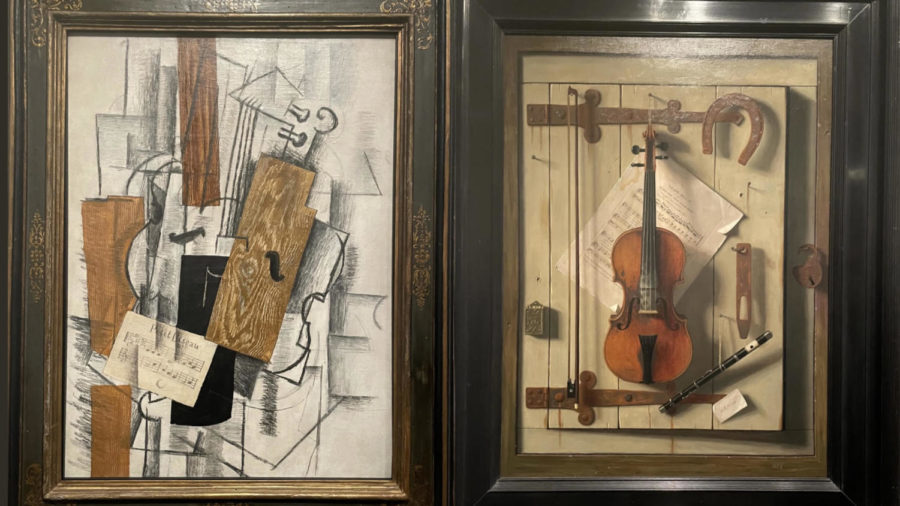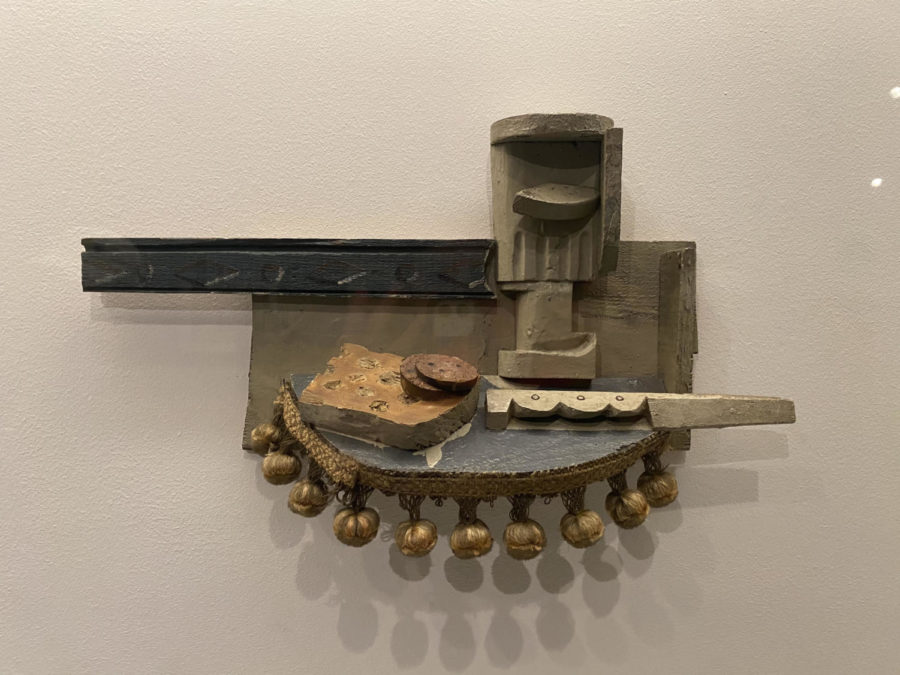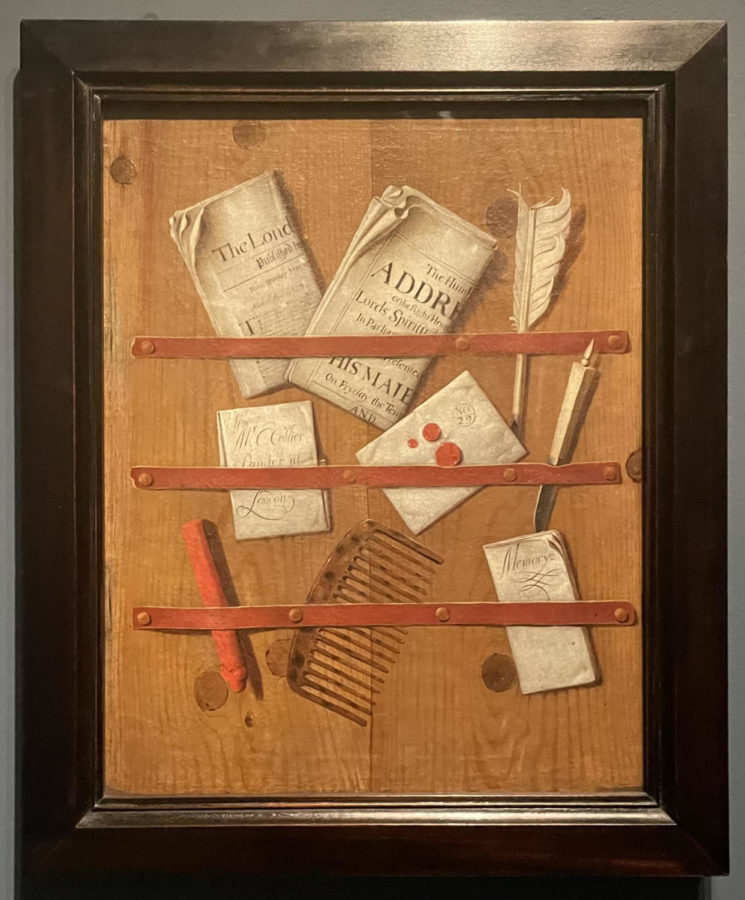A Comprehensive Cubist Compendium: A Review of ‘Cubism and the Trompe l’Oeil Tradition’ at the MET Museum
Famed through the work of Georges Braque, Juan Gris, and Pablo Picasso, Cubism has its humble origins in ancient Greek hyperrealism. The MET Museum exhibit adds color to this story, shedding light on the unsung heroes of illusionism in art.
At the forefront of the ‘Cubism and the Trompe l’Oeil Tradition’ exhibit at the MET Museum are two different depictions of a violin, one Cubist and one realist.
Grapes, curtains, and ancient Greece: these are an unlikely combination, yet they are the foundation of a cubism. The creative cultural concept was born when two Greek painters, Parrhasius and Zeuxius, came into competition, resulting in a realist rivalry.
Roman author Pliny the Elder recounts the artistic affray: Zeuxis “produced a picture of grapes so successfully that birds flew up to it. Whereupon Parrhasius painted such a realistic representation of a curtain that Zeuxis requested that the curtain should be drawn. When Zeuxis realized his mistake, he yielded up the prize, saying that whereas he had deceived birds, Parrhasius had deceived him, an artist.”
The author’s words are plastered onto the entrance of the ‘Cubism and the Trompe l’Oeil Tradition’ exhibition at the Metropolitan Museum of Art. On display through January 22nd, 2023, the Ancient Greek feud introduces a collection of cubist ingenuity.
Still Life with Chair Caning, the first collage of its kind, is the exhibit’s opening artwork. Crafted in 1912 by Pablo Picasso, widely recognized as the father of cubism, the flat, ovular canvas evokes images of three dimensional objects. Its bottom left section resembles a weave-chair, and its framing – a mere rope – mimics a “braided” frame, thus imitating an imitation.
Picasso combines this collage tactic with paint in The Scallop Shell: “Notre Avenir est dans l’Air.” Again utilizing an ovular canvas, its right hand side features the French flag, the phrase “notre avenir est dans l’air” (our future is in the air) is inscribed upon it.
The piece recreates a Michelin advertisement for airplane tires, referencing a lasting joke between Picasso and his cubist counterpart, Georges Braque. The two posited that their contributions to the artistic world parallel that of the Wright brothers in aviation, dubbing themselves pioneers of cubism – and rightfully so.
“Guernica is the best example of Picasso’s geometric trailblazing, combining earlier styles of artwork which were focused on deconstructionism with political messaging,” said Thibault Kelsohn ’23.
In a similar spirit of illusionism, Trompe l’Oeil Still Life incorporates both visual and verbal cues which form a mirage of there being a frame. This style, dubbed quodlibet after the Latin phrase for “whatever you please,” weaves together seemingly random strings of words and pictorial motifs.
Dutch painter Samuel van Hoogstraten completed the work in the late seventeenth century, and having successfully deceived the Holy Roman Emperor, Ferdinand III, into seeing a frame, received a gold medal in order to recognize his artistic aptitude.
A few years prior and a couple of miles east, Cornelius Norbertus Gijsbrechts produced The Attributes of the Painter in Copenhagen. It is an almost exact representation of a wall in his studio, including realistic representations of his brushes, paint palette, and maulstick, used for supporting the artist’s painting hand.
Positioned directly above these tools is a painting of a painting; the replicated canvas peels off of the wall behind it and induces various emblems. The worn-out candle and fallen hourglass before the black background, for one, represent the transience of life, giving meaning to The Attributes of the Painter as a whole.
In its corner is a palette knife, carefully positioned so as to support a piece of paper. Disguised as a mere note in his studio, Cornelius Norbertus Gijsbrechts included his signature on this sheet. This technique is reminiscent of cartellino, the Renaissance trompe l’oeil technique which uses paint to mimic a signature on paper.
Employing the same strategy, Flemish artist Wallerant Vaillant created the illusion of ink in A Board with Letters, Quill Knife, and Quill Pen behind Red Straps. Completed in 1658, the oeuvre pioneered the appearance of letter racks in art, encouraging reflection on its authenticity.
Adding to the illusion of notes attached to the painting’s surface is the inclusion of a quill, positioned to the right of the notes that are seemingly attached to the painting’s surface. Sealed with red wax, each of the letters evoke false images of real paper.
But “art is not truth,” said Pablo Picasso in 1923. “Art is a lie that makes us realize the truth. The artist must convince others of the truthfulness of his lies.”
American artist William Michael Harnett did so by replicating the presence of paper in his 1888 work, Still Life – Violin and Music. In a reference to Harnett’s Irish heritage, a music sheet from the collection Irish Melodies dangles from a padlock in the background. Before it are a violin and piccolo, both of which appear in other works by the painter, presenting a common theme.
The painting strikes a harmonious balance between cubism and hyperrealism. It has a geometric element to it, adding to the sense of illusion created by the phony presence of depth. In this sense, Still Life – Violin and Music “suggest[s] a sense of detached impersonality,” as described by the curator on the wall copy accompanying this painting.
Depicting the same objects in a slightly different style is Trompe L’Oeil with Violin, Music Book, and Recorder, completed by Cornelius Norbertus Gijsbrechtsin in 1672. The piece maintains a heavy motif of music, presenting an alternate form of self-expression in lieu of the artist’s more evident vessel of painting.
Atop an array of sheet music, held in place by a red leather strap, is yet another violin and a plethora of writing quills. These objects are depicted at a slight incline, “leaning” towards a letter folded over the red band. Addressed to Danish King Christian V, it reveals the artist’s position as court painter and simultaneously serves as his signature.
“Status was a key element of art in the seventeenth century,” said Katia Anastas ’23. “Many Baroque artists typically used a grandiose element of richness in their work, but some were more direct and showcased their political ties, for example.”
Nearly a century later, cubism took on a third dimension in Tournai, Belgium. A 1750 coffee pot made of soft-paste porcelain mimics the texture of wooden plank, as was popular in late eighteenth century art. The pot’s accompanying dessert plate is of the same pattern, and is adorned with a landscape print and the artist’s signature.
Akin to the “wooden” material of the dishes is the background of Trompe L’Oeil of an Etching by Ferdinand Bol. The work is thus ahead of its time; painted in 1675, its pattern would not become popular until almost two centuries later. The nature of the piece’s wood is, in itself, a mirage. It is made out of oak wood, but was painted over to resemble pine.
Trompe L’Oeil of an Etching by Ferdinand Bol is a picture of a picture, showcasing a print of revered Dutch artist Rembrant. The work’s creator is anonymous, but is illustrative of the debt Ferdinand Bol felt to the Baroque printmaker, having learned much of his artistic apprehension from Rembrant.
As if to imply previous use, the creased “paper,” attached to the “wall” by way of red wax, curls towards the viewer. It thus establishes the illusion of depth, transcending beyond the flat surface.
Akin to this interactive element is that of Musical Instruments, a 1665 painting by Italian artist Evaristo Baschenis. Baschenis almost invites audiences to touch the scene he created, with open drawers, crumpled papers, and silky ribbons strewn atop a table.
The seemingly random assortment of objects lay beside a variety of violins and fruit. Most of the instruments have broken strings and are unplayable, while the apples to their left are close to rotten. The decaying of these items is reminiscent of the impermanence of life, and maintains a somber tone by referring to the eventual decay of every living thing.
Baschenis’s signature is further inventive. Engraved on the table’s leg in Musical Instruments, he incorporates a subtle but critical detail, given that the artist was nearly forgotten in Italy during this time.
Picasso, who had a more long-lasting legacy, also incorporated fruit into his works. Used as a celebratory motif in Still Life with Compote and Glass, the festivities are completed with cake and a bottle of rum. Countering this with a solemn tone is a blackened relic of French paper Le Journal, perhaps influenced by the world war which ensued during the painting’s creation in 1915.
An element of illusion can be found in the plethora of cutouts in the foreground, presenting a wide range of colors and materials. From fake granite to dotted wallpaper (the latter of which he used in his previous papiers collés works), Picasso establishes an element of texture in Still Life with Compote and Glass.
Utilizing color to a much greater extent is Still Life with a Guitar, made by Spanish artist Juan Gris in 1913. Amidst the bright yellow and blue hues, potent shadows are cast by each object. Outlined clearly in the center is a guitar, but more abstractly depicted glasses, pipes, and bottles are included as well. Gris purposefully bends their shadows in an almost rebellious act against the laws of nature, explicitly referencing the criminal underworld of the pulp-fiction series Fantômas.
The incorporation of such geometric pieces in tandem with realistic still lifes renders the ‘Cubism and the Trompe l’Oeil Tradition’ exhibition at the MET as an exceptional one. Though slightly redundant (the image of a violin, for instance, is recurring), each of the pieces work cohesively in order to create a captivating, cubist narrative. Owing to ancient Greek rivals Parrhasius and Zeuxius, Cubism forever altered the artistic world. Yet it all started with a mere bowl of grapes.
“Art is not truth,” said Pablo Picasso in 1923. “Art is a lie that makes us realize the truth. The artist must convince others of the truthfulness of his lies.”
Sela Emery is a Copy Chief for 'The Science Survey.' She focuses on art history, covering relevant art pieces and exhibitions with each issue. In addition...













